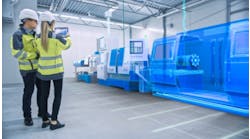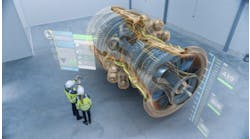AR, wearables streamline processes for Lockheed Martin
By Kyle Shamorian, Control Global digital managing editor
The age-old adage of man vs. machine applies more befittingly to the manufacturing sector than perhaps any other industry. Implementing new technologies requires investment and risk, and even if that implementation is successful, the conversation then shifts to whether the employee—who was responsible for the task now accomplished by the technology—may no longer be needed.
The key to finding a balance, according to Rick Boggs, retired senior fellow at Lockheed Martin, is not to think in terms of replacing employees with new technologies, but rather to use those technologies to empower the individual to do their jobs more effectively.
In his presentation, “Empowering Humans at the edge,” at Smart Industry 2017, Boggs explored the opportunities afforded by new technologies, as well as the challenges in convincing others to think differently.
“When dissecting an airplane, you’ll see that each F-35 fighter jet has six ridges, and each ridge requires a one-hour inspection six different times, where a person physically checks for drill holes, fasteners, wiring, etc.,” Boggs explained. “And if the company is supposed to produce 3,300 F-35s, you can do the math.”
In effort to save time and money—as well as reduce human error—Boggs and his team decided to run an experiment during one of these inspections in hopes of conducting them more efficiently.
“Camera technology has advanced such that we could take a picture of the as-manufactured piece and let a computer compare it to the as-built drawings,” Boggs said. “We were able to save 45 minutes per inspection of a bulkhead,” and eventually “$16 million in savings over the lifecycle manufacturing of that part.”
Following the success of this experiment, Boggs decided to apply this kind of approach to other projects as well.
“Everyone’s enamored with HoloWalls and HoloLenses, so we take time out of the engineering design phase by presenting three-dimensional drawings and three-dimensional objects to the design team,” he said. “They get away from their computers, their drafting tables, and they look around their objects—most of them for the first time—and see the space contextual value.”
With this new perspective, Boggs said, his team was able to identify issues they may not have otherwise seen. “They were finding things like a latch was a little low, or if you pull this engine in and out 100 times, you exceed the load value on the connectors. Things they never thought of before, using technology.”
Man vs. machine
The assumption that every employee can be replaced by a robot is a false one, Boggs stressed, noting that a robot can’t take contextual information and use it; it can only use rule-based information. What the industry should think about is how people and technology can work together symbiotically to fill in the gaps left by the other.
“So much of an aircraft mechanic’s day consists of traveling to the shop, getting the work order, collecting spare parts and tools, and reading through manuals,” he said, noting that over 50% of the day is considered non-productive, one in four projects results in an error, and there’s often one safety issue per day. “He’s dealing with things that if they were automated, he wouldn’t’ have to deal with.”
Boggs believes that using technology to make employees aware of analytics and IoT data will offer a deeper understanding of the project they’re working on, and will invariably improve capabilities. “The value proposition is that insight plus context equals execution.”
The biggest challenge as an innovator is not the technology itself, but rather convincing people that process change is good, according to Boggs.
“When we saved $16 million over the manufacturing lifecycle of a single part, how much do you think the technology cost to do that?” he asked. “About $1,000. It costs more convincing people to change their process than it does to develop the technology.”
According to Boggs, one of the most exciting and potentially impactful technologies are wearables and augmented reality. Though for AR to reach that potential, a case must be made for investing in them.
“AR is time-saving, innovative, and can solve the world’s problems, but it doesn’t pass business models. It doesn’t give enough cost savings or to the bottom line to get implemented,” he said. “The key is to build an infrastructure by taking dissimilar pieces of information and technology, and showing how they can work together.”
Despite the obstacles, however, Boggs’ outlook remains positive. “If we harness technology and act on the data it provides, we’ll improve the process, improve work flow, and improve productivity—all going down to the bottom line. Then the technology will pay for itself.”

